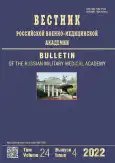Qualimetric assessment of research and development performance of a higher education institution
- Authors: Ivchenko E.V.1, Grigoriev S.G.1, Ovchinnikov D.V.1, Latypov I.F.1
-
Affiliations:
- Military Medical Academy of S.M. Kirov
- Issue: Vol 24, No 4 (2022)
- Pages: 719-725
- Section: Original Study Article
- URL: https://journals.rcsi.science/1682-7392/article/view/134072
- DOI: https://doi.org/10.17816/brmma111049
- ID: 134072
Cite item
Abstract
The study presents an original methodology for assessing the quality of scientific activity of the units of the Military Medical Academy named after S.M. Kirov. As a tool for its solution, we used qualimetric evaluation of all possible areas of scientific activity of departments and criteria that characterize these areas. Qualimetric methods of expert survey and weighting of performance indicators and descriptive statistics were used. Twenty-five experts took part in structuring the scientific performance of the academy. The resulting structure included six main sections, each described by a specific set of attributes. The attributes were both quantitative and qualitative with certain graduations and units of measurement, each of which was assigned a weighting coefficient. The values of the coefficients were expressed in fractions of 1, and the sum was 1. The consistency of the experts proved to be quite high, and the coefficient of concordance was 0.82 (p < 0.001). Based on the comprehensive assessment of each division of the academy, a scale score was calculated, which helped in determining the rating of a division. A sigma (using the mean square deviation) estimate was chosen as a scaling tool, which shows that 68% of all complex estimates of the units being evaluated are expected in the range from the arithmetic mean minus sigma to the arithmetic mean plus sigma. That is, units with the value of a complex indicator that falls within this interval are recognized as units with an average assessment of scientific activity. Approximately 16% of units whose value of the complex indicator will be greater than the calculated interval will make up a group of units with scientific activity above the average, and the same number of units whose value of the complex indicator will be less than the calculated interval will make up a group of units with scientific activity as below the average. In general, following the structuring and weighting coefficients, a calculation complex was developed to determine the scientific status of a unit, which was performed using an Excel spreadsheet and can be used, along with the evaluation of educational and methodological activities, in the general evaluation of units.
Full Text
##article.viewOnOriginalSite##About the authors
Evgeniy V. Ivchenko
Military Medical Academy of S.M. Kirov
Email: latypov_ildar85@mail.ru
ORCID iD: 0000-0001-5582-1111
SPIN-code: 5228-1527
doctor of medical sciences, associate professor
Russian Federation, Saint PetersburgStepan G. Grigoriev
Military Medical Academy of S.M. Kirov
Email: latypov_ildar85@mail.ru
SPIN-code: 2391-4846
doctor of medical sciences, professor
Russian Federation, Saint PetersburgDmitriу V. Ovchinnikov
Military Medical Academy of S.M. Kirov
Email: latypov_ildar85@mail.ru
ORCID iD: 0000-0001-8408-5301
SPIN-code: 5437-3457
candidate of medical sciences, associate professor
Russian Federation, Saint PetersburgIldar F. Latypov
Military Medical Academy of S.M. Kirov
Author for correspondence.
Email: latypov_ildar85@mail.ru
ORCID iD: 0000-0003-4849-9261
SPIN-code: 2926-6607
candidate of medical sciences
Russian Federation, Saint PetersburgReferences
- Zubkova TM, Natochaya EN. Rating assessment of academic staff in a university based on an automated information system. Software and Systems. 2019;(3):525–533. (In Russ.). doi: 10.15827/0236-235X.127.525-533
- Laptev VV, Potemkin MN. Vnutrivuzovskie reitingi kafedr v sfere nauchnoi deyatel’nosti kak mekhanizm aktivizatsii nauchnoi raboty v universitete. Byulleten’ Uchenogo Soveta. 2006;(8(34)):3–20. (In Russ.).
- Sharshov IA. Otsenka effektivnosti nauchno-issledovatel’skoi deyatel’nosti v sovremennom universitete. Psychology-Pedagogical Journal Gaudeamus. 2014;(1(23)):38–44. (In Russ.).
- Azgaldov GG. Immeasurable or unmeasured. Product quality control. 2021;11:44–47. (In Russ.).
- Azgaldov GG, Kostin AV, Metrology and qualimetry: identification issues. The world of torments. 2021;2:69–73. (In Russ.).
- Pankova LA, Petrovsky AM, Schneiderman MV. Organizatsiya ekspertiz i analiz ekspertnoi informatsii. Moscow: Science; 1984. 120 р. (In Russ.).
- Cherepanov VS, Lyubimova OV. Kvalimetricheskii podkhod v obrazovanii. Education and Science Journal. 2009;63(6):36–43. (In Russ.).
- Sheshukova TG. Sergeeva NV. Formirovanie sistemy pokazatelei dlya otsenki effektivnosti nauchnoi deyatel’nosti natsional’nykh issledovatel’skikh universitetov. Economic Analysis: Theory and Practice. 2012;(4(259)):53–63. (In Russ.).
- Ivchenko EV, Ovchinnikov DV, Zubenko AI, etc. Istoricheskii ocherk nauchnogo otdela Voenno-meditsinskoi akademii. Saint Petersburg: VMA; 2016. 152 р. (In Russ.).
- Ovchinnikov DV. Scientific research of military medicine and training of scientific personnel in its interests (to the 90th anniversary of the department of organization of scientific work and training of scientific and pedagogical personnel of the Military Medical Academy). Izvestia of the Russian Military Medical Academy. 2021;40(3):5–12. (In Russ.). doi: 10.17816/rmmar76030
- Ekspertnye otsenki. Beshelev SD, Gurvich FG, editors. Moscow: Nauka; 1973. 157 р. (In Russ.).
- Fadeeva OM. Primenenie kvalimetrii kak teoreticheskoi bazy otsenki kachestva sistemy strategicheskogo upravleniya vysshim uchebnym zavedeniem. Sotsial’naya Politika i Sotsiologiya. 2013; (4-1(96)):24–35. (In Russ.).
- Korneshchuk NG, Rubin GSh, Abramova TV. Kvalimetriya kak instrument otsenki kachestva obrazovaniya. Standarty i Monitoring v Obrazovanii. 2006;(3):16–9. (In Russ.).
- Junkerov VI, Grigoriev SG, Rezvantsev MV. Matematiko-statisticheskaya obrabotka dannykh meditsinskikh issledovanii. Saint Petersburg: VMA; 2011. 318 р. (In Russ.).
Supplementary files








